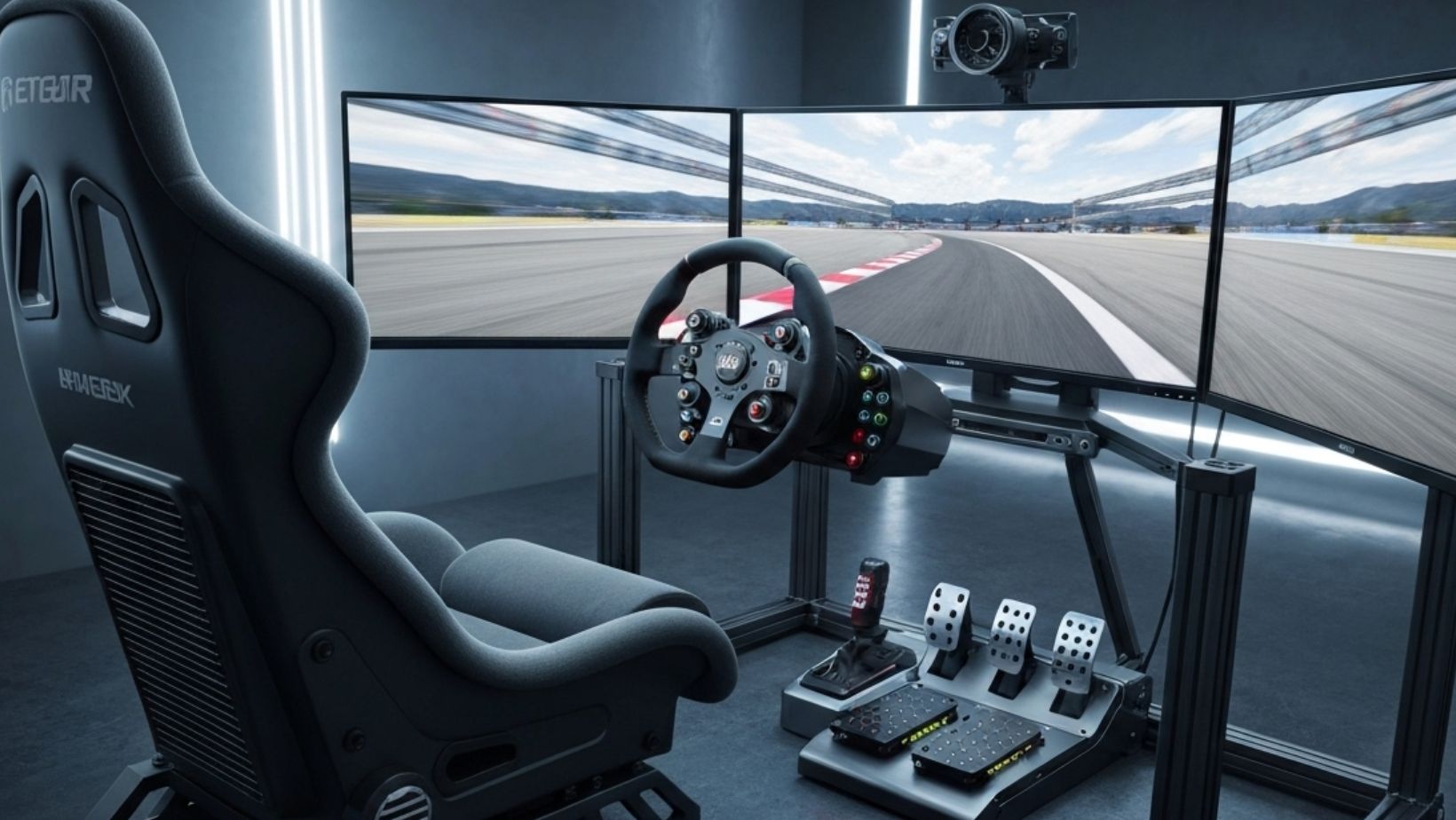
Key Highlights
- A dedicated racing seat enhances immersion and stability in your sim rig.
- Ergonomics and posture support are crucial for comfort during long races.
- The right seat offers adjustable components for a perfect custom fit.
- Material choice, like fabric or leather, impacts breathability and durability.
- Consider seat types, such as a bucket seat or reclining seat, based on your needs.
- Always check compatibility and mounting options to ensure the sim racing seat fits your racing cockpit.
Introduction
Welcome to the thrilling world of sim racing! You’ve likely spent time perfecting your wheel and pedal setup, but what about where you sit? The right seat is more than just a place to park yourself; it’s the central component that connects you to the virtual track. A proper sim racing seat transforms your setup from a desk-based game into a truly immersive racing cockpit. It provides the stability, comfort, and correct posture you need to shave seconds off your lap times and race for hours on end.
Key Features of the Best Seats for Sim Racing Rigs
When searching for the perfect sim racing seat, it’s easy to get lost in the details. The key is to focus on features that directly enhance your racing experience. You need a seat that not only feels comfortable but also provides the rigidity to handle intense force feedback and heavy braking without flexing. The right seat should make you feel secure and connected to your sim rig.
A crucial aspect is finding the correct seating position, which mimics that of a real race car. This involves looking at adjustability, material, and overall design. What features should I look for in the best seats for sim racing rigs? Let’s explore the essential elements that separate a good seat from a great one.
Ergonomics and Posture Support
Ergonomics should be at the top of your checklist. During a long endurance race, poor posture can lead to discomfort, fatigue, and even pain, which can ruin your concentration and performance. A well-designed racing seat is built to hold you in a supportive and natural position, reducing strain on your back, neck, and shoulders.
The best seats are shaped to cradle your body, providing support in all the right places. Look for designs that feature contoured backrests and raised side bolsters. This kind of posture support ensures that you remain comfortable and focused, even when you’re hours into a race.
Ultimately, the goal is to find a racing seat that fits your specific body shape. A seat that’s too wide won’t offer enough support, while one that’s too narrow will feel restrictive. Proper ergonomics are the foundation of a comfortable and competitive sim racing setup.
Adjustable Components for Custom Fit
No two drivers are the same, so why should their seating positions be identical? Adjustable components are essential for achieving a truly custom fit. The ability to fine-tune your seat’s position relative to your pedals and wheel is what allows you to find that perfect, comfortable, and responsive driving posture. This is where features like seat sliders and adjustable seat mounts come into play.
These components give you control over key aspects of your setup. With the right hardware, you can tailor your cockpit to your exact preferences, ensuring optimal comfort and control. Key adjustable components to look for include:
- Seat Sliders: These allow you to move the seat forward and backward easily, just like in a real car.
- Adjustable Seat Brackets: These let you change the height and angle of the seat, helping you achieve the ideal recline and elevation.
By utilizing these adjustable parts, you can create a setup that feels like it was built just for you. This level of customization is vital for both comfort and performance, allowing you to react faster and race longer.
Comfort Factors to Consider for Long Racing Sessions
Comfort is not a luxury in sim racing; it’s a necessity, especially when you’re settling in for long sessions. An uncomfortable seating position can quickly become a distraction, pulling your focus away from the race. The best sim racers know that maintaining physical comfort is key to sustaining mental sharpness lap after lap. Your racing cockpit should be a place where you can sit for hours without feeling sore or fatigued.
When evaluating a seat, think about factors beyond its shape. The materials, padding, and breathability all play a significant role in your overall comfort. Let’s look at what makes some seats better than others for those marathon races.
Padding, Cushioning, and Lumbar Support
One of the most important comfort factors is the quality of the padding and cushioning. A race seat might look sleek, but if the padding is too thin or made from low-density foam, you’ll start to feel the pressure points sooner rather than later. High-density foam is ideal as it provides firm support that doesn’t compress and flatten over time, ensuring consistent comfort.
Beyond the main cushioning, dedicated lumbar support is a game-changer. Many seats come with a built-in lumbar curve or a separate, adjustable cushion. This feature helps maintain the natural curve of your lower spine, preventing the slouching that often leads to back pain during extended sim racing sessions.
When choosing a seat, pay attention to how the padding is distributed. Good designs offer ample cushioning for your back and thighs without being so bulky that they interfere with your connection to the chassis. This balance is key to creating a supportive yet responsive feel.
Breathability and Temperature Regulation
Intense sim racing sessions can get heated, both figuratively and literally. As your heart rate climbs, your body temperature rises, and a non-breathable seat can quickly become uncomfortable and sweaty. This is where material choice plays a crucial role in temperature regulation. A seat that traps heat can be a major distraction and source of discomfort.
For maximum breathability, certain materials are far superior to others. How does seat material affect the sim racing experience? It has a huge impact on comfort. Materials to consider for better airflow include:
- Fabric Upholstery: Materials like Alcantara or other textiles allow air to circulate freely, wicking away moisture and keeping you cool.
- Perforated Sections: Some seats, even leather ones, incorporate perforated or mesh panels in key areas like the back and seat base to promote ventilation.
While a standard gaming chair might prioritize plush looks, a purpose-built racing seat often focuses on performance materials that keep you cool under pressure. This focus on breathability is a small detail that makes a big difference during a long, competitive race.
Types of Seats Used in Sim Racing Rigs
When choosing a seat for your sim racing rig, you’ll generally encounter two main categories: bucket seats and gaming chairs. While they can sometimes look similar, their design philosophies are quite different. A bucket seat is designed to mimic the seat from a real car, offering maximum support and a fixed, aggressive posture to keep you locked in place.
On the other hand, a gaming chair is often designed for more general use, prioritizing adjustability and multi-purpose comfort over pure racing ergonomics. Each type of race seat has its pros and cons, and the right choice for you depends on your priorities for immersion, comfort, and versatility.
Bucket Seats vs Gaming Chairs
The debate between a bucket seat and a gaming chair is a common one for sim racers. Bucket seats are purpose-built for racing. They feature high side bolsters on the back and base to hold you securely in place, which is essential for feeling the feedback from your rig and resisting the forces of heavy braking. This design, inspired by a real car, offers an unparalleled level of immersion and stability.
Conversely, a gaming chair is a jack-of-all-trades. It typically offers more adjustability, including recline, adjustable armrests, and a more relaxed posture. While comfortable for general gaming or office work, it often lacks the rigidity and deep, supportive shape of a true race seat. The softer padding and less aggressive bolstering mean you may experience more flex and movement in your sim rig.
Ultimately, the choice depends on your primary use. If you want the most authentic and stable racing experience, a bucket seat is the way to go. If you need a versatile chair for both racing and other activities, a high-quality gaming chair could be a suitable compromise.
| Feature | Bucket Seat | Gaming Chair |
| Primary Goal | Immersion & Stability | Versatility & General Comfort |
| Posture | Fixed, aggressive | Relaxed, adjustable |
| Support | High side bolsters | Lower, softer bolsters |
| Rigidity | High, minimal flex | Moderate, can have some flex |
| Best For | Dedicated sim rigs | Multi-purpose setups |
Fixed Back vs Reclining Options
Within the world of dedicated racing seats, you have another important choice: fixed back or reclining. A fixed back seat, true to its name, has a shell that is one solid piece. This design offers the absolute best rigidity and feedback transmission. Because there are no moving parts in the backrest, every vibration and G-force sensation from your racing simulator is transferred directly to your body, enhancing immersion.
A reclining seat, however, offers greater versatility and comfort adjustment. Just like in a road car, you can change the angle of the backrest to find a more relaxed or aggressive posture. This makes it easier to get in and out of the rig and allows for fine-tuning your comfort for different types of racing or even for different users. The trade-off is a slight reduction in rigidity due to the reclining mechanism.
The choice from the range of sim racing seats available depends on your priorities. If you are a purist seeking maximum stiffness and the most authentic feel, a fixed back seat is your best option. If you value adjustability, ease of use, and the ability to find a perfect comfort angle, a reclining seat is an excellent choice.
Materials and Build Quality in Sim Racing Seats
The material and build quality of a racing seat are about more than just looks; they define its durability, comfort, and overall feel. A well-built seat uses a strong frame and high-quality upholstery to withstand the rigors of intense racing sessions for years to come. From the fabric that touches your skin to the frame that provides support, every component matters.
Whether it’s the premium feel of Alcantara, the durability of vinyl, or the lightweight strength of a carbon fiber shell, the materials used will significantly impact your racing experience. Let’s examine how different materials and construction methods contribute to a top-tier seat for next-level racing.
Fabric vs Leather vs Synthetic Materials
Choosing the right surface material for your sim racing seat is a balance of comfort, durability, and maintenance. Each option has distinct advantages that cater to different preferences.
- Fabric: Materials like Alcantara, suede, or other cloths are highly breathable and offer excellent grip, helping to hold you in the seat during intense maneuvers. They are soft to the touch and don’t get as hot or cold with changing room temperatures. The downside is that they can be more susceptible to stains and wear over time.
- Leather: Genuine leather offers a premium look and feel, and it’s very durable and easy to clean. However, it tends to be less breathable, which can lead to discomfort during long, warm sessions. It can also be more slippery than fabric.
- Synthetic Materials: Faux leather, vinyl, and other synthetics provide a great balance. They offer the easy-to-clean durability of leather at a more affordable price point. Many modern synthetics also offer better breathability than traditional leather, making them a popular and practical choice for sim racers.
Frame Construction and Durability
The hidden skeleton of your racing seat, its frame, is the foundation of its strength and durability. A weak or flexible frame will undermine the entire purpose of a dedicated racing seat, failing to provide the rigid support needed to handle force feedback and braking forces. The material used for the frame is the primary determinant of its performance.
Most sim racing seats use a tubular steel frame, which offers an excellent combination of strength, durability, and affordability. For those seeking higher performance, fiberglass frames provide a significant increase in rigidity and a weight reduction. At the very top end, you’ll find carbon fiber frames, which offer the ultimate in stiffness and lightweight construction, perfectly mimicking the seats found in high-end race cars.
Regardless of the material, solid construction is key. Check for clean welds on steel frames and a smooth, robust finish on composite shells. The frame’s integrity, along with sturdy seat brackets, ensures your seat will remain a stable and reliable part of your rig for countless races.
Compatibility and Mounting Options
You’ve found a seat you love, but will it fit your rig? This is a critical question that requires a look at compatibility and mounting options. Not all seats are designed to fit all cockpits, and figuring this out beforehand will save you a major headache. The mounting pattern on the bottom or sides of the seat needs to align with the hardware on your rig.
Fortunately, many seats and rigs are designed with some level of cross-compatibility in mind. Understanding the difference between universal mounts and dedicated systems, and whether you might need additional brackets, is key to a smooth installation process.
Universal Mounts vs Dedicated Sim Rig Mounts
When it comes to attaching your seat, you’ll typically encounter two types of mounting solutions: universal and dedicated. Universal seat mounts are designed to be versatile. They usually consist of side brackets with multiple slots and holes, allowing them to accommodate a wide variety of seats and bolt onto different rig platforms. This flexibility is great if you have a custom-built rig or want to ensure your seat can move to a new cockpit in the future.
Dedicated sim rig mounts, on the other hand, are designed by a manufacturer to work specifically with their own brand of seats and cockpits. The advantage here is a guaranteed perfect fit with no guesswork. The mounting holes will line up precisely, and the hardware is optimized for that specific combination, often resulting in a simpler installation and a very solid connection.
While dedicated mounts offer peace of mind, universal mounting options provide greater freedom of choice. If you opt for a universal solution, just be sure to double-check the measurements of your seat and rig to ensure a good fit.
Seat Sliders, Brackets, and Hardware Essentials
Getting your sim racing seat mounted is just the first step; dialing in its position requires the right hardware. Seat sliders and brackets are not just accessories; they are essential components for achieving an ergonomic and comfortable driving position in your racing cockpit.
- Seat Sliders: These are rails that bolt between the seat and the rig, allowing you to slide the seat forward and backward. This is crucial for quickly adjusting the distance to your pedals, and it’s a must-have if different people will be using the same rig.
- Seat Brackets: These connect the seat to the sliders or directly to the rig. Side-mount brackets are common for bucket seats and offer adjustability for the height and recline angle of the seat. Bottom-mount brackets are more common on reclining seats.
Having a quality set of this hardware is vital. Strong, well-made sliders and brackets will ensure your seat is secure and free of any unwanted wobble or flex. Always ensure the hardware you choose is compatible with your specific sim racing seat.
Sizing and Fit for Sim Racing Seats
Just like a helmet or a race suit, a sim racing seat must fit correctly to be effective. A seat that is too large will not provide the lateral support needed to hold you in place, while a seat that is too small will be uncomfortable and restrictive. The goal is to find a race seat that feels snug and supportive without being tight.
Manufacturers often produce seats in different sizes to accommodate a wide range of body shapes. Paying close attention to sizing charts and taking your own measurements is a critical step in the buying process. A proper fit ensures comfort, support, and a better connection to your rig.
Measuring for Optimum Fit
So, how do you pick the right size for your sim racing seat? It starts with taking a couple of simple measurements. The most important measurement is your waist or hip width at the widest point while seated. Compare this number to the manufacturer’s sizing chart for the seat’s internal width. You want a snug fit, but with enough room to be comfortable.
Another useful measurement is your shoulder width. Check this against the width of the seat at the shoulder bolsters to ensure you’re not squeezed. Some manufacturers also provide a recommended height and weight range, which can be a helpful guide.
Don’t just rely on your trouser size, as seat measurements are more specific. Taking a few moments to measure your body shape will pay huge dividends in comfort and support. If you’re on the border between different sizes, it’s often better to go with the slightly larger option to avoid feeling cramped.
Weight Capacity and Adjustability
Beyond just the fit, it’s important to consider the weight capacity of a sim racing seat. Every seat is engineered with a maximum recommended weight limit to ensure its structural integrity and safety. Exceeding this limit can put stress on the frame and seat mounts, potentially leading to failure. Always check the manufacturer’s specifications to ensure the seat can comfortably support your weight.
Adjustability also plays a role in accommodating different body types. Even within a specific size, features that allow you to customize the fit can make a big difference. These include:
- Adjustable cushion inserts to change the feel and fit.
- Side-mount seat brackets with multiple holes for height and angle adjustments.
- The ability to pair the seat with sliders for easy distance tuning.
These features, combined with choosing a seat that meets the right weight capacity, ensure that your investment is both safe and perfectly tailored to you, providing a solid foundation for your sim rig.
Practical Tips Before Buying a Sim Racing Seat
Choosing the most seats for sim racing rigs can feel like a big decision, but a little preparation goes a long way. Before you make a final choice, take a step back and think about the big picture. Consider your budget, your current setup, and your long-term sim racing goals. The right sim racing seat is an investment that should enhance your racing experience for years to come.

A great seat should not only be comfortable and supportive today but should also fit into your plans for future upgrades. Thinking about these practical aspects will help you select a seat that you’ll be happy with for the long haul.
Budget Considerations and Value for Money
Setting a realistic budget is the first step in your search. The range of sim racing seats available is vast, with prices varying significantly based on materials, brand, and features. It’s tempting to go for the cheapest option, but this can often lead to disappointment in terms of comfort and durability. Likewise, the most expensive seat isn’t always necessary for an incredible experience.
The key is to find the best value for your money. Look for seats that offer essential features like a strong frame, supportive ergonomics, and quality padding within your price range. Sometimes, spending a little more upfront on a well-built seat from a reputable source can save you money in the long run, as it will last longer and provide a better experience.
Consider what features are “must-haves” versus “nice-to-haves.” Do you absolutely need a carbon fiber shell, or would a sturdy steel or fiberglass frame suffice? Balancing your desires with your budget will lead you to a seat that provides great performance without breaking the bank, taking your setup to the next level.
Upgradability and Future-Proofing Your Setup
A sim racing setup is rarely static; it evolves as you get more serious about the hobby. When choosing a seat, think about how it will fit into your plans. A good seat should be a long-term investment that can adapt as your rig grows.
Consider a seat with a unique design that allows for easy integration of accessories. For example, will you be able to easily add shifter mounts, handbrakes, or button boxes later on? Some seats and mounting systems are more modular than others, making future upgrades much simpler.
Key aspects for future-proofing include:
- Standardized Mounting: A seat with a standard side-mount or bottom-mount pattern will be compatible with a wider range of future cockpits and accessories.
- Durable Construction: A high-quality frame will withstand the addition of more powerful wheelbases and pedals.
- Versatile Design: A seat like a Trak Racer Rally Style model might offer a good balance of comfort and support that works for various racing disciplines.
By thinking ahead, you can choose a seat that not only meets your current needs but also serves as a solid foundation for the ultimate sim rig you dream of building.
Conclusion
In conclusion, selecting the best seats for sim racing rigs is essential for enhancing your overall racing experience. Prioritising comfort, ergonomic support, and compatibility with your rig can make a significant difference during those long sessions. Consider factors such as padding, breathability, and adjustability to ensure a perfect fit that meets your needs. With various materials and designs available, you have the flexibility to choose a seat that not only looks great but also provides the durability required for intense gameplay. Remember, investing in the right seat is an investment in your performance and enjoyment. So take your time, evaluate your options, and get ready to elevate your sim racing setup! If you’re ready to upgrade your experience further, don’t hesitate to explore more about the best options out there.






